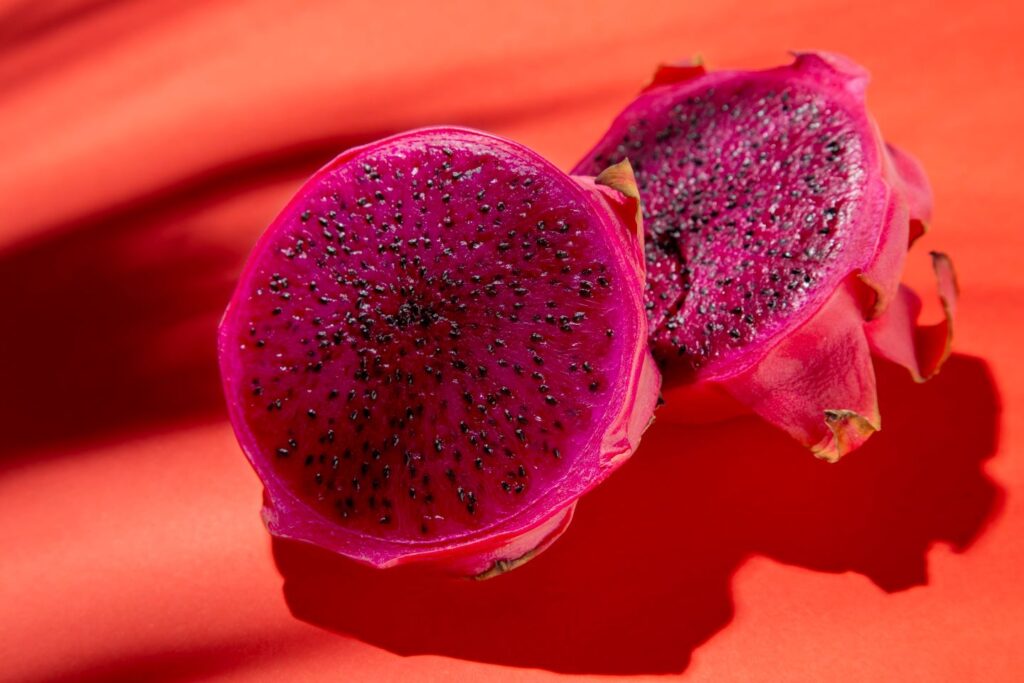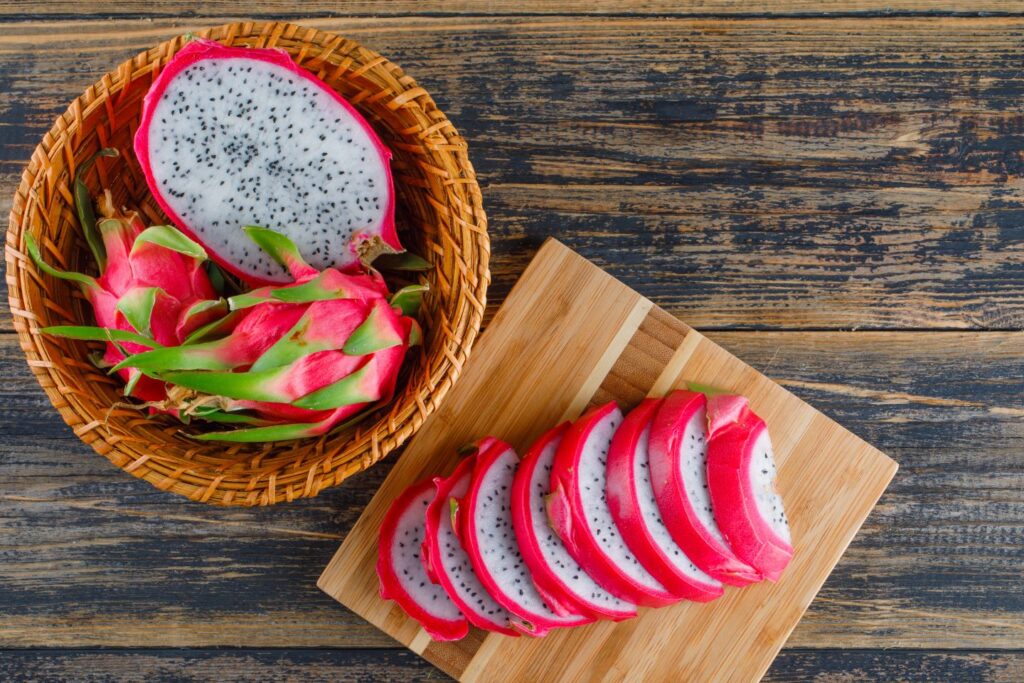Purple Dragon Fruit: From Exotic Beauty to Culinary Marvels

The purple dragon fruit, sometimes called pitaya or pitahaya, is a captivating jewel that stands out in the rich tapestry of exotic fruits. With its vivid colours and distinctive design, this tropical treat has drawn the interest of foodies and health-conscious people. Together, let’s discover the secrets and benefits of the purple dragon fruit.
Sources and Types: The Global Rise of Purple Dragon Fruit
Although it originated in Central America, purple dragon fruit has spread worldwide, especially to Southeast Asia and the United States. It grows well in tropical and desert areas and is popular in places like Vietnam, Thailand, the Philippines, and Mexico. It is a member of the cactus family.
Dragon fruit comes in a variety of types, although the Hylocereus undatus and Hylocereus costaricensis are the most widely available. The former, also called the white-fleshed dragon fruit, has green scales on its skin that are a vivid pink color, and its pulp is white with small black seeds scattered throughout. The latter, known as the purple dragon fruit, has flesh that contrasts sharply between a rich purple or white skin and a deep magenta interior.
Dragon Fruit Delight: Beauty and Culinary Elegance of Purple Dragon Fruit!
It would be important to mention their breathtaking appearance before discussing the purple dragon fruit’s charms. This unusual fruit has thick, leathery skin covering its outside that resembles the scales of a dragon from myth. It immediately draws attention with its vivid hues, which range from magenta to deep purple and is, therefore, a highly desirable addition to fruit displays and culinary masterpieces.
When the fruit is cut open, the pulp, which can be solid or speckled in color, is interestingly punctuated by small black seeds. Purple dragon fruits are elevated to the status of works of art due to the dramatic visual effect produced by the contrast between their vibrant surface and their delicate, pale flesh.
Nutritious Wealth: A Feast for the Eyes and Body
The purple dragon fruit is visually stunning but has a very healthy nutritional profile. This unusual fruit complements a well-balanced diet because it is a rich source of important vitamins, minerals, and antioxidants.
Vitamin C is one of the purple dragon fruit’s main nutritional components. Strong antioxidants like vitamin C are essential for maintaining healthy skin, boosting the immune system, and facilitating iron absorption. The fruit also has several B vitamins that support general energy metabolism, such as B1 (thiamine), B2 (riboflavin), and B3 (niacin).
Purple dragon fruit is a great option for anyone trying to maintain a healthy weight and promote digestive health because it is also low in calories and fiber. The high fiber content helps to maintain a healthy digestive tract, lessen overeating, and increase feelings of fullness.
Adaptability in Cuisine: From Snack to Gourmet Delight
- The purple dragon fruit is a nutritional powerhouse but has additional appeal due to its culinary versatility. The flesh is a flexible component that works well in savory and sweet recipes because of its mild, somewhat sweet flavor.
- The purple dragon fruit can be eaten raw, spooned out, or split into wedges in its most basic form. On its alone, its mild sweetness makes it a cool snack that is ideal for hot summer days. On the other hand, fruit salads can benefit from the fruit’s distinct texture and vivid colors, which also provide a touch of sweetness.
- The mild flavor of purple dragon fruit pairs well with a range of other fruits and toppings in smoothie bowls, demonstrating its adaptability. Blending it into smoothies adds a healthy aspect to the mixture and a lovely hue.
- Purple dragon fruit has been welcomed by chefs and home cooks alike, who have invented it to enhance savory dishes, sauces, and desserts. The only restrictions are in one’s imagination, from dragon fruit sorbets to salads dressed with vinaigrettes.
Purple Dragon Fruit Benefits
In addition to being aesthetically pleasing with its vivid purple flesh and green scales, purple dragon fruit, also known as pitaya or pitahaya, has several health advantages. The following are a few possible advantages of eating purple dragon fruit:
- Packed with Nutrients: Iron, calcium, phosphorus, vitamin C, and vitamin B are just a few of the vital elements found in purple dragon fruit. These nutrients are essential for good health and well-being in general.
- Antioxidant Properties: Flavonoids, phenolic compounds, and betalains are some antioxidants found in purple dragon fruit, just like in other colorful fruits. By assisting the body in eliminating dangerous free radicals, these antioxidants lower the chance of developing long-term conditions, including cancer and heart disease.
- Immune System Support: Purple dragon fruit’s high vitamin C concentration helps strengthen the immune system, assisting the body in fending off infections and diseases.
- Enhances Digestive Health: Purple dragon fruit is rich in dietary fiber, which facilitates regular bowel movements and helps with digestion. In addition to lowering the risk of colon cancer, fiber also aids in preventing constipation.
- Heart Health: Purple dragon fruit’s potassium and magnesium contents can lower blood pressure and enhance cardiovascular health. Furthermore, the fruit’s fiber and antioxidants may help decrease cholesterol and lower the risk of heart disease.
- Hydration: The high water content of purple dragon fruit can aid in maintaining the body’s ideal fluid balance.
- Weight management: Purple dragon fruit can be a nutritious addition to a diet plan for weight loss or weight management because of its high fiber content and low-calorie level. By encouraging feelings of fullness, fiber helps lower total calorie consumption.
- Skin Health: By lowering oxidative stress and inflammation, the antioxidants and vitamin C in purple dragon fruit may assist in supporting healthy skin. The fruit can also be applied topically and used as an ingredient in skincare products or as a natural sunburn cure.
Although purple dragon fruit has a lot of potential health benefits, it’s crucial to remember that it’s only one part of a balanced diet. Including a wide range of fruits and vegetables in your diet is essential to ensure you get all the nutrients you need for good health.

A Water-Wise, Eco-Friendly Approach to Agriculture!
It is important to pay close attention to the environmental factors when cultivating purple dragon fruit. Since cacti are native to arid regions, they do best in soil that drains efficiently and retains little water. The environmentally friendly growth of dragon fruit involves little pesticide treatment and efficient use of water.
Furthermore, dragon fruit plants are a desirable alternative for sustainable agriculture because of their capacity to thrive on marginal sites with little water availability. Dragon fruit farming offers a potential solution to water constraints in certain areas by giving farmers a hardy and profitable crop.
The Financial Effect: Beyond Borders, Beyond Taste
In addition to its influence on the culinary world, the purple dragon fruit’s appeal has grown to be a major economic force in the areas where it is grown. Dragon fruit production has increased in nations like Vietnam, Thailand, and the Philippines, boosting the economy generally and generating job opportunities.
Due to customer demand for this tropical treasure’s unique tastes and health advantages, the dragon fruit export business has grown significantly globally. The fruit’s direct production is not the only aspect that benefits the economy; its widespread use has given rise to allied sectors such as supplements, cosmetics, and processed dragon fruit goods.
Difficulties and Things to Think About
The purple dragon fruit has many benefits, but it also has difficulties. The fruit’s shelf life is limited by its delicate nature, making it prone to breakage during shipping. Variations in growing conditions can also impact the fruit’s flavor and appearance, making it difficult to sell consistently high-quality fruit.
Concerns regarding sustainability have been raised in some locations due to the water demands of dragon fruit farming, particularly in areas where water is scarce. Ensuring the long-term sustainability of dragon fruit cultivation requires the implementation of sustainable agricultural practices and technical breakthroughs.
Purple Haze Dragon Fruit: An Improbable Wonder
When it comes to naming new varieties in the field of dragon fruit cultivation, names are frequently derived from characteristics that set them apart, such as color, flavor, or growth environment. One of the interesting combination of qualities that set the “Purple Haze” dragon fruit variety apart from other exotic fruits.
- Shades: Considering the name “Purple Haze,” one would anticipate focusing on vivid purple colors. The outside of the fruit may have an enticing purple gradient that makes for a visually appealing appearance. The pulp might remain a deep purple, enhancing its ethereal and mysterious aspect.
- Profile of Flavor: The “Purple Haze” dragon fruit’s flavor may be a pleasing fusion of sweet and somewhat sour undertones, making for a pleasurable palate experience. The flavor’s intensity may evoke A sense of intricacy, enticing connoisseurs to savor the subtleties with every bite.
- The Composition of Nutrition: The “Purple Haze” dragon fruit variety may provide many nutritional advantages, just like other types. Its popularity as a health-conscious option among consumers may be attributed to its high quantities of vitamin C, fiber, and antioxidants.
- Conditions for Cultivation: The “Purple Haze” dragon fruit might be cultivated peculiarly to certain climates, highlighting the best conditions for developing its distinct flavor and color. This could involve considering temperature sensitivity, water requirements, and soil type.
- Effect on the Market: A unique name like “Purple Haze” for a dragon fruit variety could pique attention in the agricultural and culinary sectors and among consumers. Its market influence may go beyond the fruit itself, encouraging the development of items infused with dragon fruit or new culinary techniques.
Purple Dragon Fruit Taste: A Symphony of Sweetness and Tanginess
Purple dragon fruit is sometimes described as having a sweet, slightly tangy flavor. For example, its flavor profile may differ slightly based on maturity and variety. Purple dragon fruit typically has a mildly sweet flesh that tastes like a strawberry and pear hybrid. Some people have even compared it to a melon.
Because of the little edible seeds scattered throughout the flesh, the fruit’s feel is frequently compared to that of a kiwi. The crunch of these seeds slightly accentuates the fruit’s silky smoothness.
Dragon fruit purple is a popular choice for eating on its own or as a component in various foods and beverages such as smoothies, salads, and desserts. Overall, the flavor experience is pleasant and refreshing.
Purple Dragon Fruit vs White
White and purple dragon fruits, sometimes called pitahayas or pitayas, are produced by many Hylocereus cactus species. There are some variations between the two types in terms of look, flavor, and texture, even though they both have comparable nutritional advantages:
- Color: The color of their flesh and skin distinguishes purple and white dragon fruit from one another the most. White dragon fruit has pink or yellow skin with white flesh, while purple dragon fruit has vivid purple-red skin with white or purple flesh.
- Taste: Purple dragon fruit usually has a significantly sweeter flavor than white fruit. The sweetness of white dragon fruit is softer, more delicate, and slightly acidic.
- Texture: Both types’ soft, luscious flesh is dotted with tiny, tasty seeds. Their textures are comparable. On the other hand, some claim that purple dragon fruit is a little firmer than white dragon fruit.
- Availability: Certain areas, especially in Southeast Asia and Central and South America, are better places to find purple dragon fruit. On the other hand, white dragon fruit is typically grown in tropical and subtropical areas of the world and is more accessible.
- Nutritional Content: Vital vitamins, minerals, and antioxidants are abundant in purple and white dragon fruit. They are a nutritious snack or side dish option because they are low in calories and fat.
Note: There are differences in the appearance and taste of purple and white dragon fruit, although having many of the same nutritional advantages and textures. Which version you like most depends on personal preference, or you may find that trying both allows you to appreciate their distinct features better.

Purple Dragon Fruit vs Red Dragon Fruit
Although the phrases “purple dragon fruit” and “red dragon fruit” are sometimes used synonymously, they usually refer to the same dragon fruit variety, Hylocereus polyrhizus. The striking purple-red skin and white or purple meat dotted with tiny black seeds are the distinguishing features of this cultivar. The purple/red dragon fruit is contrasted with other common types here:
- Nutritional Value: Vitamin C, vitamin B, iron, calcium, phosphorus, and other important vitamins, minerals, and antioxidants are abundant in purple/red dragon fruit. It is a healthy snack or side dish option because it is low in calories and fat.
- Taste: The purple or red dragon fruit flavor is slightly sweet and tangy. Many people characterize the taste as a blend between a melon and a strawberry, while others compare it to a pear and kiwi combo. The degree of sweetness can change according to maturity and growth circumstances, among other things.
- Look: The skin of the purple and red dragon fruits is vivid and brilliant, with comparable purple-red tones. The hue of the flesh might vary slightly, from deep purple to white with purple streaks.
- Texture: Typically, the smooth, delicious flesh of purple or red dragon fruit is dotted with tiny, edible seeds, making it soft and juicy. The fruit’s texture is slightly crunchier overall because of the seeds.
Note: Purple and red dragon fruit is essentially the same kind with comparable traits and nutritional advantages despite some small variances in flavor and texture between individual fruits. Their vivid color, crisp flavor, and many health advantages make them both popular options for eating.
Purple Dragon Fruit Near Me
Due to its increasing popularity, purple dragon fruit, also known as purple pitaya or Hylocereus costaricensis, is becoming more accessible in many places. Here are some ideas for potential locations to locate purple dragon fruit in your area:
- Local Grocery Stores: Purple dragon fruit can be found in many well-stocked grocery stores, especially those specializing in fresh produce and other unique things. It’s frequently found with other tropical fruits or in the area dedicated to exotic fruits.
- Farmers’ Markets: Locally grown produce, including unusual fruits like purple dragon fruit, can be found at farmers’ markets. When they are in season, local farmers might sell them.
- Asian markets: A large range of fruits, including dragon fruit, are frequently found in Asian markets or specialty food stores. If purple dragon fruit is in season, they may have it available.
- Online retailers: Try searching for online stores focusing on exotic fruits or tropical produce if you need help finding purple dragon fruit nearby. They might provide delivery choices to your location.
- Local Orchards and Farms: In areas with climates conducive to purple dragon fruit cultivation, some orchards and farms may cultivate the fruit. To find neighboring farms specializing in tropical fruits, you can check with regional agricultural associations or conduct an internet search.
Important Note: As availability may vary based on the season and region, it’s a good idea to phone ahead or check online to see if purple dragon fruit is in stock at the store or market before heading out.
Conclusion
The purple dragon fruit is a symbol of beauty, nutrition, and economic vigor in the wide world of exotic fruits. This fruit, which originated in Central America and is now widely cultivated in tropical places worldwide, has captured the hearts and palates of people everywhere despite cultural and culinary barriers.
Purple dragon fruit is attractive not only because of its eye-catching look but also because of its many health advantages and adaptability in the kitchen. The purple dragon fruit has become a major participant in the food market as people look for more unusual and healthy options. It provides a great sensory experience and improves the health of those who eat it. Purple dragon fruit is a fruit that never fails to enchant and inspire. It can be eaten raw, blended into smoothies, or creatively incorporated into dishes to experience the unique flavors of the tropics.





